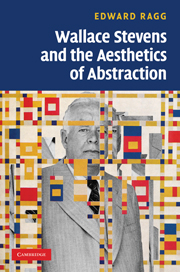Book contents
- Frontmatter
- Contents
- Acknowledgements
- List of Abbreviations
- Introduction: ‘Stevensian’ and the question of abstraction 1935–2009
- 1 The abstract impulse: from anecdote to ‘new romantic’ in Harmonium (1923) and Ideas of Order (1935)
- 2 The turn to abstraction: Owl's Clover (1936) and the ‘un-locatable’ speaker in The Man with the Blue Guitar (1937)
- 3 The ‘in-visible’ abstract: Stevens' idealism from Coleridge to Merleau-Ponty
- 4 Abstract figures: the curious case of the idealist ‘I’
- 5 Abstract appetites: food, wine and the idealist ‘I’
- 6 The pure good of theory: a new abstract emphasis
- 7 Bourgeois abstraction: poetry, painting and the idea of mastery in late Stevens
- Bibliography
- Index
2 - The turn to abstraction: Owl's Clover (1936) and the ‘un-locatable’ speaker in The Man with the Blue Guitar (1937)
Published online by Cambridge University Press: 04 August 2010
- Frontmatter
- Contents
- Acknowledgements
- List of Abbreviations
- Introduction: ‘Stevensian’ and the question of abstraction 1935–2009
- 1 The abstract impulse: from anecdote to ‘new romantic’ in Harmonium (1923) and Ideas of Order (1935)
- 2 The turn to abstraction: Owl's Clover (1936) and the ‘un-locatable’ speaker in The Man with the Blue Guitar (1937)
- 3 The ‘in-visible’ abstract: Stevens' idealism from Coleridge to Merleau-Ponty
- 4 Abstract figures: the curious case of the idealist ‘I’
- 5 Abstract appetites: food, wine and the idealist ‘I’
- 6 The pure good of theory: a new abstract emphasis
- 7 Bourgeois abstraction: poetry, painting and the idea of mastery in late Stevens
- Bibliography
- Index
Summary
How does it matter how I play
Or what I color what I say?
It all depends on inter-play
Or inter-play and inter-say,
Like tweedle-dum and tweedle-dee,
Or ti-ri-la and ti-ri-li
And these I play on my guitar
And leave the final atmosphere
To the imagination of the engineer.
I could not find it if I would.
I would not find it if I could.
The two years following Ideas of Order formed a period of intense experimentation for Stevens. Although he would omit ‘Owl's Clover’ from the 1954 Collected Poems, his attempt at a quasi-allegory concerning the function of art in the Depression marked a greater engagement with ‘reality’ than Ideas had achieved (despite poems such as ‘Mozart, 1935’). The jacket statement to the trade edition of Ideas defensively asserted: ‘The book is essentially a book of pure poetry.’ Whilst Stevens acknowledged ‘economic […] political and social changes’, he apparently sought a modernized ‘pure poetry’ rather than abandoning one kind of verse for a socially more responsive but poetically less sophisticated idiom. As we have seen, however, Ideas of Order was anything but ‘pure poetry’ in the sense of verse aspiring to the condition of music, of sounds miraculously free from the significant world. Harmonium too thrived on a tension between Symbolist experiment (‘To the One of Fictive Music’), poems that revel in sonority (‘Bantams in Pine-Woods’) and more ‘theoretical’ explorations of self and world (‘A High-Toned Old Christian Woman’, ‘Theory’, ‘Thirteen Ways of Looking at a Blackbird’, ‘The Snow Man’ and so on).
- Type
- Chapter
- Information
- Wallace Stevens and the Aesthetics of Abstraction , pp. 55 - 77Publisher: Cambridge University PressPrint publication year: 2010



